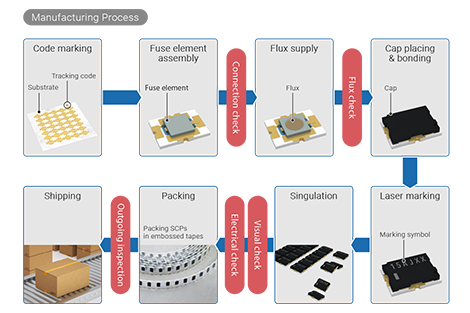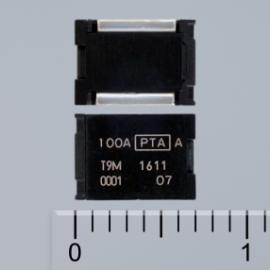Surface mounted type fuse
for High Current
Li-ion batteries
What is Surface mounted type fuse?
The surface mounted type fuse, Self Control Protector (SCP), protects Li-ion batteries from overcurrent and overcharge. SCP is widely used in Li-ion batteries in mobile devices (such as smartphones, tablet PCs and notebook PCs), power tools and electric bicycles.

How does it work?
Li-ion batteries are small/lightweight high-performance power sources. However, they differ from other types of batteries in that they are highly volatile and flammable when overcharge. For this reason, their battery management system (BMS), which controls charge/discharge requires added safety to prevent both overcurrent and overcharge.
Dexerials' SCP is a fuse installed in the BMS. When a battery is overcharged, a large current passes through an internal heater and generates heat. The heat melts the fuse element placed directly above the heater. In addition, an external short-circuit (overcurrent) produces Joule heat that melts a fuse element just like a common fuse. In both cases, safety of the battery is improved by physically isolating the battery from the circuit.
-

Example of overcharge protection
When the heater melts the fuse element to prevent overcharging, the current stops flowing through the heater as soon as the charging circuit is cut off. -

Example of current protection
Joule heat produced by an overcurrent melts the fuse element to stop the current.
Reasons for choosing Dexerials’ SCP
#1 market share in secondary protection fuse market.
Top market share in standard products for Li-ion battery packs, with cumulative shipments of over 2 billion units

High product quality
All general electronic components are either inspected or spot-checked during the manufacturing process. Since Dexerials’ SCP is an important component to ensure the safety of Li-ion batteries, Dexerials conducts strict inspections at many stages to guarantee high product quality and reliability.

Wide product line-up
We offer a wide range of products from small, low impedance to high impedance, high current products that can handle high currents from 60 A to 120 A

Any question?
Get in touch with our product experts.
Product lineup for High Current Li-ion Batteries
60 Amperes SFK Series Self Control Protector(SCP)
Features

- Achieving rated current 60 Amperes as a surface mounted fuses.
- Applicable up to 10 cells in series.
- Protects Li-ion batteries from overcharging (overvoltage) and overcurrent.
- When overcharging occurs, the fuse element melts to shut off the circuit, and simultaneously the power to the heater is also cut off.
- Placing a heater directly under the fuse element breaks the circuit quickly.
Specifications
| Product name | SFK-1260 | SFK-1460 | SFK-2060 | SFK-3060 | SFK-4060 | SFK-5060 |
|---|---|---|---|---|---|---|
| Applicable cells in series | 3 cells | 4 cells | 5 cells | 6 to 7 cells | 9 to 10 cells | 12 to 14 cells |
| Rated current(A) | 60 | |||||
| Rated voltage(VDC)* | 80 | |||||
| Rated breaking capacity(A) | 160 | |||||
| Operating voltage(V) | 9.6 to 13.5 | 13.0 to 18.4 | 16.7 to 23.5 | 22.3 to 31.5 | 33.0 to 46.9 | 43.7 to 62.0 |
| Heater resistance(Ω) | 1.83 to 2.75 | 3.1 to 5.1 | 5.6 to 8.4 | 10.0 to 15.0 | 22.0 to 33.0 | 38.5 to 57.76 |
| Fuse resistance(mΩ) | 0.8 | |||||
| Dimension(mm) | 9.5 x 5.0 x 2.0 | |||||
*Maximum voltage at which cutoff of the fuse is possible. It is not the operating voltage for the heater.
UL certification: File No. E167588
TUV certification: Certificate No. J9650637
RoHS directive: Conforming
120 Amperes SFM Series Self Control Protector(SCP)
Features

- Offers a rated current of 120 Amperes as a package that can be mounted with screws.
- Applicable up to 14 cells in series.
- Protects Li-ion batteries from overcharging (overvoltage) and overcurrent.
- When overcharging occurs, the fuse element melts to shut off the circuit, and simultaneously the power to the heater is also cut off.
- Placing a heater directly under the fuse element breaks the circuit quickly.
Specifications
| Product name | SFM-120120 | SFM-14120 | SFM-20120 | SFM-30120 | SFM-40120 | SFM-50120 |
|---|---|---|---|---|---|---|
| Applicable cells in series | 3 cells | 4 cells | 5 cells | 6 to 7 cells | 8 to 11 cells | 12 to 14 cells |
| Rated current(A) | 120 | |||||
| Rated voltage(VDC)* | 80 | |||||
| Rated breaking capacity(A) | 300 | |||||
| Operating voltage(V) | 8.2 to 13.5 | 10.8 to 18.0 | 14.2 to 23.5 | 18.9 to 31.5 | 29.7 to 49.5 | 37.7 to 62.0 |
| Heater resistance(Ω) | 1.0 to 1.6 | 1.8 to 2.7 | 3.0 to 4.7 | 5.5 to 8.3 | 13.6 to 20.5 | 22.0 to 33.0 |
| Fuse resistance(mΩ) | 0.5 | |||||
| Dimension(mm) | 40.0 x 29.4 x 6.0 | |||||
*Maximum voltage at which cutoff of the fuse is possible. It is not the operating voltage for the heater.
UL certification: File No. E489967
RoHS directive: Conforming
100 Amperes PTA Series Power Current Protector(PCP)
Features

- Surface mountable large-current fuse for protecting electronic devices from overcurrent.
- Small and thin with a height of 2 mm and a rated current of 100 Amperes.
- Our unique fuse element with a low resistivity helps a small package, and achieves a large rated current.
- This is a Pb-free* product.
* The European RoHS Directive, which restricts the use of hazardous substances, defines Pb-free as a Pb content of 1,000 ppm or less.
Specifications
| Product name | PTA-036100 |
|---|---|
| Rated current(A) | 100 |
| Rated voltage(VDC)* | 36 |
| Rated breaking capacity(A) | 300 |
| Fuse resistance(mΩ) | 0.4 |
| Dimension(mm) | 7.0 x 5.0 x 2.0 |
UL certification: File No. E489967
RoHS directive: Conforming
Any question?
Get in touch with our product experts.
Solutions for high current Li-ion Batteries
Parallel connections
allow high currents
to be handled
By connecting two or more SCPs in parallel, it is possible to handle high currents. The schematic below shows that by connecting three 30 A SCPs in parallel, a high current of 90 A can be handled. The key point of this circuit is that a diode (rectifier) is connected to a heater (resistor), which heats up and blows the fuse element. By adding a diode at a specific location or adding a FET (field effect transistor) with the same function, reliable circuit shutoff becomes possible even with multiple SCPs connected in parallel.

Overvoltage protection divided
into discharging and charging
The diagram on the right is an example of a circuit where SCP is installed in devices that require instantaneous high currents, such as cordless power tools and electric motorcycles. The key point is that the discharging circuit where a high current flow and the charging circuit are designed separately, while the SCP is used only for the charging circuit.
Generally, the current used for charging is low, from 3 to 10 A, even for power tools and other electric tools. On the other hand, it's common for devices to require a high current of 100 A or more when an electric motorcycle starts climbing a hill. If the charging and discharging circuits are the same, the high current during this discharging may cause the SCP to break.
Therefore, when applying SCP for mobility or power tool system with a battery, the circuit should be divided into a discharging circuit and a charging circuit and it may only be used for a charging circuit designed for overvoltage protection.
